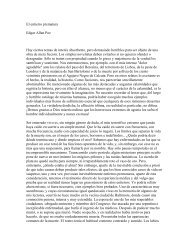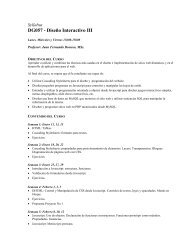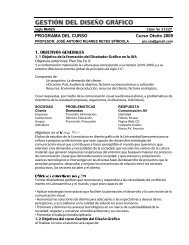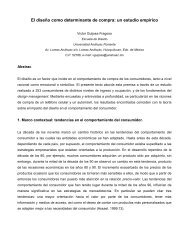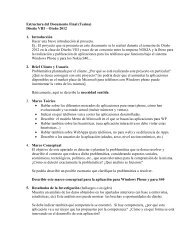Diseño sin FronterasDesign & Cultural Diversity:contributions of cross-cultural studies for the project ofproducts and services to a plural world.Maria Luiza ParanhosPUC - RioVera DamazioPUC - Riovdamazio@puc-rio.brRosa Marina MeyerPUC - RioWe are constantly in contact with other cultures. Forinstance: when reading the newspapers, when shoppingonline, when having a business or a vacation trip, whencontacting an international company, when dinning in anoriental restaurant (or occi<strong>de</strong>ntal, <strong>de</strong>pending on the homecountry of our rea<strong>de</strong>r), when watching movies, listening tomusic from other countries. The daily life is intercultural.We interact and coexist with “foreign” people, productsand services, all of the time. On the other hand, we are allgui<strong>de</strong>d by a <strong>de</strong>termined and exclusive set of rules, values,behaviors, habits and conducts that i<strong>de</strong>ntify us and, at thesame time, distinguish us from others. Cultural singularitiesshould not be consi<strong>de</strong>red worse or better, right or wrong.On the contrary, they must be valued and un<strong>de</strong>rstood.Planning, <strong>de</strong>veloping and offering products and servicesfor users from different cultures requires attention, careand, above all, knowledge. In such context, it is crucial andurgent that Design expands its cultural horizons in or<strong>de</strong>rto meet the necessities and <strong>de</strong>sires of a society more andmore diverse each day.This paper aims at presenting Cross Cultural Studies as animportant field for <strong>de</strong>sign actions. It introduces the culturalcategorization mo<strong>de</strong>ls of Richard Lewis (2006) and GeertHofste<strong>de</strong> (2005) respectively and fundamental conceptsof cross-cultural and intercultural communication, such as“intercultural competence”.The main objective of this paper is to contribute to the<strong>de</strong>sign of cross-cultural products and services throughtheoretical and methodological data.Design and Cross-CulturalismIn 2002, AIGA – American Institute of Graphic Arts, - has establishedthe Center for Cross-Cultural Design 1 (AIGA|XCD),aiming to create, expand and exchange knowledgeabout the intersection between Culture & Design, Cross-Culturalism and its communication aspects. According toAIGA|XCD’s manifesto:Technology, mass media and a global economy have ma<strong>de</strong>the world smaller, and the scope of cross-cultural audiencesbigger for the <strong>de</strong>sign profession. It is imperative for <strong>de</strong>signersto think beyond their national and cultural bor<strong>de</strong>rs inor<strong>de</strong>r to create visual communication that is responsive tothe diversity of audiences today.In or<strong>de</strong>r to achieve its aims, the new AIGA chapter has beengui<strong>de</strong>d by the following consi<strong>de</strong>rations 2 : All <strong>de</strong>signers have a responsibility to investigate theunique characteristics of their audience including theones that reflect cultural differences. Design operates on a global scale and in many caseswill reach enormously diverse audiences (whether weintend it to or not). Design must address the needs of both local andglobal. Although <strong>de</strong>sign can easily be experienced ona global scale through communication technologyand travel, the <strong>de</strong>signer must realize the impact localcommunities have on perception. The <strong>de</strong>sign community is well positioned to helpcompanies meet international marketing challenges.Unfortunately, however, many businesses are notlooking to the <strong>de</strong>sign profession for solutions to theseproblems. Designers must find a way to better communicatethe value they bring to global business. Learning about other cultures requires interaction withother cultures. Creating and connecting with venuesat home and abroad can increase this interaction.1 Look at http://xcd.aiga.org/2 Look at http://xcd.aiga.org/manifesto.html23
MX Design Conference 2011 No one person can know all there is to know aboutany culture. Cross-cultural <strong>de</strong>sign is about building anetwork and learning from others. Design education is key to producing a new generationof <strong>de</strong>signers comfortable with and responsive to<strong>de</strong>sign on a global scale. Seeking mutual un<strong>de</strong>rstanding between peoples andcultures can only lead to greater peace in the world.Besi<strong>de</strong>s the creation of the Center for Cross-Cultural Design,AIGA and ADOBE <strong>de</strong>veloped a research untitled “Definingthe Designer of 2015” to better un<strong>de</strong>rstand the emergingrole of future <strong>de</strong>signers and to collaborate to preparestu<strong>de</strong>nts to meet the career changes and challenges 1 .The initial phase of the research revealed a range of 12<strong>de</strong>sign competencies nee<strong>de</strong>d to meet future society<strong>de</strong>mands and to be consi<strong>de</strong>red when educating futuregenerations of <strong>de</strong>signers and recruiting <strong>de</strong>sign teams.Among them, five are strongly related to cultural context,as shown below 2 :1. Broad un<strong>de</strong>rstanding of issues related to the cognitive,social, cultural, technological and economic contextsfor <strong>de</strong>sign2. Ability to respond to audience contexts recognizingphysical, cognitive, cultural and social human factorsthat shape <strong>de</strong>sign <strong>de</strong>cisions3. Management and communication skills necessary tofunction productively in large interdisciplinary teamsand “flat” organizational structures4. Ability to construct verbal arguments for solutions thataddress diverse users/audiences; lifespan issues; andbusiness/organizational operations5. Ability to work in a global environment with un<strong>de</strong>rstandingof cultural preservationThe above discussion suggests that future <strong>de</strong>signerswill have to expand their knowledge from the product’smaterial dimension to the user’s cultural context andinterpersonal relations.The well known and respected <strong>de</strong>signer Jorge Frascara(2001, 18) argues that <strong>de</strong>signers are un<strong>de</strong>rstanding “<strong>de</strong>signas the <strong>de</strong>sign of interaction between people and objects”;but now they have to “<strong>de</strong>velop a better un<strong>de</strong>rstandingof the interaction between people and people”. He addsthat <strong>de</strong>signers, when <strong>de</strong>veloping their projects, should beconcerned about how to “contribute to the <strong>de</strong>velopmentof culture, knowledge, good will, tolerance of diversity andconsciousness about the value of life”. (2000, p.127)1 Defining the <strong>de</strong>signer of 2015. Disponível em: http://www.aiga.org/content.cfm/<strong>de</strong>signer-of-20152 Tradução livre dos autores. Lista completa disponível em: http://www.aiga.org/content.cfm/<strong>de</strong>signer-of-2015-competenciesThe, also, respected Patrick Jordan, in his study entitled ‘TheGood Society Framework – Un<strong>de</strong>rstanding Quality of Life 3 ’,agrees that “in or<strong>de</strong>r that the positive effects of <strong>de</strong>sign canbe maximized, we may have to rethink the boundaries ofthe discipline to ensure that it becomes even more relevantto the wellbeing of people in the twenty-first century”.(Jordan, 2010). The author explains that:Traditionally, the main measures used to quantify a society’s level ofwellbeing have been financial measures, in particular ‘standard ofliving’, which is mainly a measure of people’s income and spendingpower.Patrick Jordan has used wi<strong>de</strong>r parameters to evaluatequality of life in a broad sense. Among them 4 , we highlightthe criteria ‘relationships”, related to the quality of interpersonaland social relationships of their members, and thatindicates whether a society can be consi<strong>de</strong>red coherentin its values and harmonious or not. Based on the aboveconsi<strong>de</strong>rations, we may suggest that the criteria ‘relationship’also inclu<strong>de</strong>s intercultural relationships, or theability of certain groups to interact with members ofdifferent cultures.Jordan also consi<strong>de</strong>rs aspects related to the cross-culturalissues on his concept of “pleasurability” (2000, p.8), whenhe affirms that if <strong>de</strong>signers are to connect fully with usersthen they have to fully un<strong>de</strong>rstand them, and look at themfrom a holistic point of view, including physical, psychological,cognitive, social, i<strong>de</strong>ological, and even spiritual dimensions,as well as the context in which the product or servicewill be used. Having a holistic un<strong>de</strong>rstanding of people isthe key to <strong>de</strong>signing the products and services that peoplewill not only find useful and enjoyable, but pleasurable.Jordan suggests four possible different kinds of pleasure<strong>de</strong>rived from interactions between a person and a product:physiological, social, psychological and i<strong>de</strong>ological. Physiological pleasures are related to the body and<strong>de</strong>rived from the senses. In the context of productsthey are connected with their textures, sounds, smellsor sensorial properties. Social pleasures are related to social interactions orproduct’s capacity to facilitate talk between people,enhance social situations and confer status and asense of belonging. Psychological pleasures are related to users’ cognitiveand emotional reactions to the performance ofproducts and services.3 JORDAN, P.The Good Society Framework - Un<strong>de</strong>rstanding Quality of Life. 2010.4 Classification parameters: relationships, economy, environment, infra-structure, health,peace and safety, culture and pleasure, spirituality, religion and philosophy, education andgovernance. (Jordan, 2010)24
- Page 2 and 3: MX Design Conference 2011Diseño si
- Page 4 and 5: ÍndiceCapeltic, una experiencia in
- Page 6 and 7: Diseño sin FronterasCapeltic, una
- Page 8 and 9: Diseño sin FronterasInvestigacione
- Page 10 and 11: Diseño sin Fronteras2) Una Empresa
- Page 12 and 13: Diseño sin Fronteras Se trabaja co
- Page 14 and 15: Diseño sin FronterasAhora bien, al
- Page 16 and 17: Diseño sin Fronteraslas personas a
- Page 18 and 19: Diseño sin FronterasDe esta manera
- Page 20 and 21: Diseño sin FronterasTercera fase:
- Page 24 and 25: Diseño sin Fronteras Ideological p
- Page 26 and 27: Diseño sin Fronterasmain objective
- Page 28 and 29: Diseño sin FronterasHofstede´s cu
- Page 30 and 31: Diseño sin FronterasJORDAN, P., De
- Page 32 and 33: Diseño sin Fronterasour personalit
- Page 34 and 35: Diseño sin FronterasThe Color in D
- Page 36 and 37: Diseño sin FronterasDesign in Teac
- Page 38 and 39: Diseño sin FronterasWe introduce t
- Page 40 and 41: Diseño sin Fronterasintellectual b
- Page 42 and 43: Diseño sin FronterasDesign Laborat
- Page 44 and 45: Diseño sin Fronterassustainable de
- Page 46 and 47: Diseño sin Fronteras4) Web design
- Page 48 and 49: Diseño sin Fronterasdemonstrating
- Page 50 and 51: Diseño sin Fronteraswith an encomp
- Page 52 and 53: Diseño sin FronterasDesign, Cultur
- Page 54 and 55: Diseño sin Fronterasb. Clothing: c
- Page 56 and 57: Diseño sin Fronterasappropriate fo
- Page 58 and 59: Diseño sin FronterasReferencesAPPA
- Page 60 and 61: Diseño sin Fronterasconocimiento 3
- Page 62 and 63: Diseño sin FronterasEntre los resu
- Page 64 and 65: Diseño sin FronterasOncología. Di
- Page 66 and 67: Diseño sin FronterasDistributed Co
- Page 68 and 69: Diseño sin Fronteras3 COLS: Web-ba
- Page 70 and 71: Diseño sin Fronterasoutcome, ‘pr
- Page 72 and 73:
Diseño sin FronterasTable 1. List
- Page 74 and 75:
Diseño sin Fronterasin which they
- Page 76 and 77:
Diseño sin FronterasWithout attent
- Page 78 and 79:
Diseño sin Fronterasexample, the d
- Page 80 and 81:
Diseño sin Fronteras(fig.1). Despu
- Page 82 and 83:
Diseño sin FronterasEl diseño est
- Page 84 and 85:
Diseño sin Fronteras1. Ser un medi
- Page 86 and 87:
Diseño sin FronterasEl diseño est
- Page 88 and 89:
Diseño sin Fronterascionados con l
- Page 90 and 91:
Diseño sin FronterasR&.)''$--)'"&+
- Page 92 and 93:
Diseño sin FronterasSegún la inve
- Page 94 and 95:
Diseño sin Fronterasde educación
- Page 96 and 97:
Diseño sin FronterasEnfoque y meto
- Page 98 and 99:
Diseño sin FronterasLos esquemas p
- Page 100 and 101:
Diseño sin FronterasWireframes - S
- Page 102 and 103:
Diseño sin FronterasEstos efectos
- Page 104 and 105:
Diseño sin Fronterasa special ques
- Page 106 and 107:
Diseño sin Fronteras“cool” tre
- Page 108 and 109:
Diseño sin Fronterasy por esta raz
- Page 110 and 111:
Diseño sin Fronterasindustrial. Va
- Page 112 and 113:
Diseño sin Fronterasmejor desempe
- Page 114 and 115:
Diseño sin Fronterasganancia econ
- Page 116 and 117:
Diseño sin Fronterasproposing solu
- Page 118 and 119:
Diseño sin Fronteras3. The first r
- Page 120 and 121:
Diseño sin FronterasInterdisciplin
- Page 122 and 123:
Diseño sin Fronterasu opor tunidad
- Page 124 and 125:
Diseño sin Fronterasla formulació
- Page 126 and 127:
Diseño sin FronterasInterdisciplin
- Page 128 and 129:
Diseño sin Fronterasreal de una or
- Page 130 and 131:
Diseño sin FronterasConclusionesHa
- Page 132 and 133:
Diseño sin FronterasEn numerosas o
- Page 134 and 135:
Diseño sin Fronterashace reflexion
- Page 136 and 137:
Diseño sin Fronterasocasiones no e
- Page 138 and 139:
Diseño sin Fronterascondición de
- Page 140 and 141:
Diseño sin FronterasLa psicología
- Page 142 and 143:
Diseño sin FronterasReferencias bi
- Page 144 and 145:
Diseño sin FronterasMetodologíaLa
- Page 146 and 147:
Diseño sin Fronterasvisión se com
- Page 148 and 149:
Diseño sin FronterasLa mediación
- Page 150 and 151:
Diseño sin Fronteraspermiten el ac
- Page 152 and 153:
Diseño sin Fronterassolo el 5% de
- Page 154 and 155:
Diseño sin FronterasFrías, J. (20
- Page 156 and 157:
Diseño sin FronterasLa noción de
- Page 158 and 159:
Diseño sin FronterasMirada de Muje
- Page 160 and 161:
Diseño sin Fronterasidentidades, d
- Page 162 and 163:
Diseño sin FronterasIntroducciónE
- Page 164 and 165:
Diseño sin Fronteraso revelan a tr
- Page 166 and 167:
Diseño sin FronterasCon respecto t
- Page 168 and 169:
Diseño sin Fronterasprofesional y
- Page 170 and 171:
Diseño sin Fronteras¿Qué es wiri
- Page 172 and 173:
Diseño sin FronterasWiring es una
- Page 174 and 175:
Diseño sin FronterasSources of inn
- Page 176 and 177:
Diseño sin FronterasFeatureDescrip
- Page 178 and 179:
Diseño sin FronterasEncoding relev
- Page 180 and 181:
Diseño sin FronterasThe new design
- Page 182 and 183:
Diseño sin Fronteraslearn by doing
- Page 184 and 185:
Diseño sin FronterasThe Open(d) Fr
- Page 186 and 187:
Diseño sin Fronterasdisseminate th
- Page 188 and 189:
Diseño sin Fronterascontrib- ute d
- Page 190 and 191:
Diseño sin FronterasThe same digit
- Page 192 and 193:
Diseño sin Fronterasque desde todo
- Page 194 and 195:
Diseño sin FronterasFigura 4 refer






